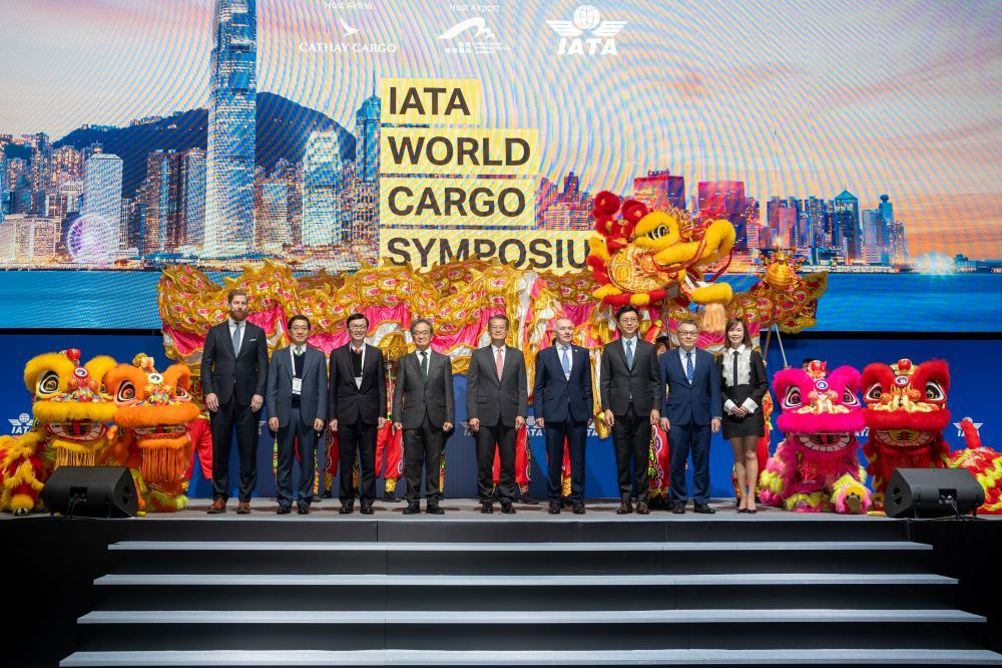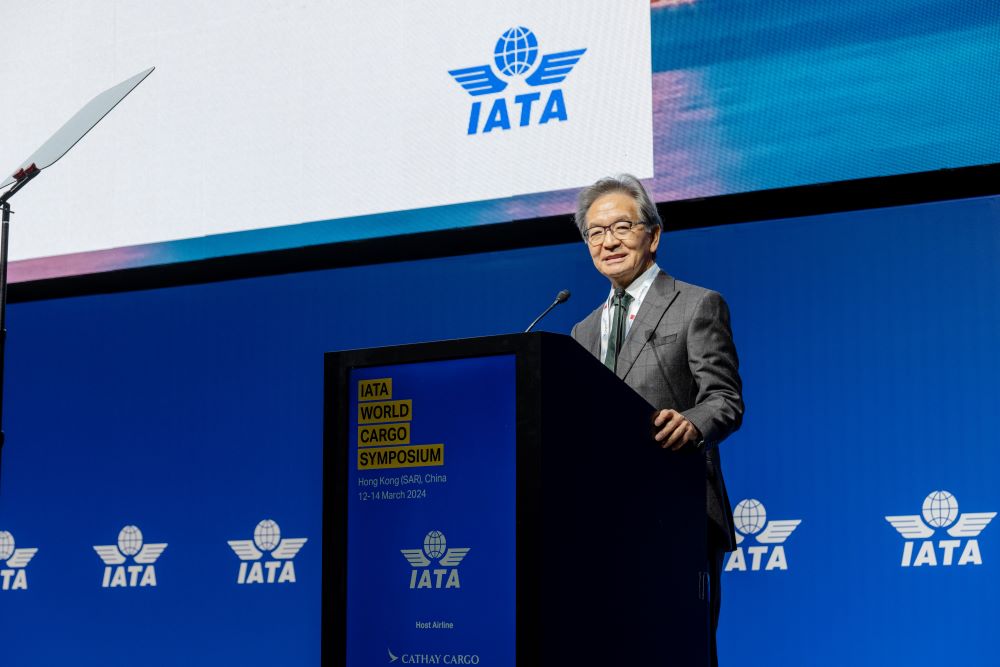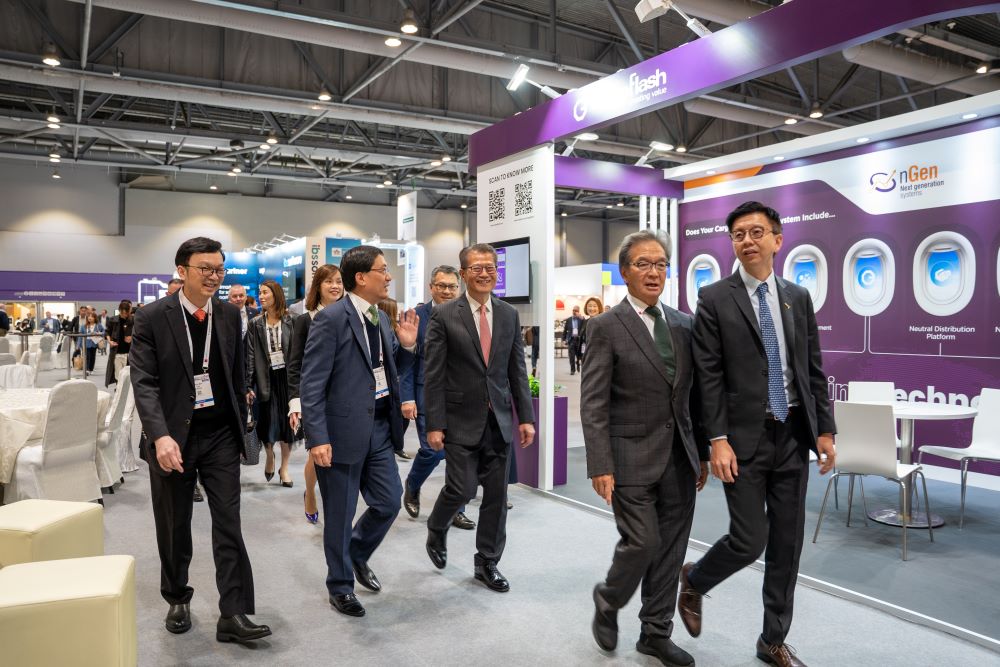
Handling over four million tonnes of cargo a year, Hong Kong International Airport has held the position of the world’s busiest cargo airport for several years, which made it a fitting location for the best attended IATA event in history.
The 17th IATA WCS had more than 1,900 registered attendees, which is a record for any IATA event, and smashed the previous record attendance for an IATA WCS set last year in Istanbul, Türkiye.
The show started with a traditional lion dance, which is customary for opening ceremonies in Hong Kong to bring good luck and abundance.
The opening plenary welcomed local dignitaries who highlighted the importance of air cargo to Hong Kong and how Hong Kong’s air cargo infrastructure benefits the world.
The first speaker was Paul Chan, Financial Secretary for the Government of Hong Kong Special Administrative Region.
He said that passenger traffic will be back at pre-pandemic levels this year and Chan said Hong Kong is just getting started with the opening of the Third Runway System.
The third runway will increase capacity to handle 120 million passengers and more than 10 million tonnes of cargo a year by 2035.
Leading companies continue to invest in Hong Kong with DHL expanding its Central Asia hub last year, the Cainiao Smart Gateway opened for business and UPS will build a new hub at the airport.
Chan added that Hong Kong is working closely with neighbouring cities in the Greater Bay Area so Hong Kong’s airport will serve as the gateway for the region.
“We are rapidly developing intermodal cargo transhipment modes in collaboration with other GBA cities such as Dongguan. For goods using Hong Kong as a hub, security screening and customs clearance will get faster and more efficient. Likewise, we are working with Zhuhai to develop international cargo business together,” Chan told the audience.
Hong Kong’s vision is getting bigger, with Chan highlighting two development directions he set out in this year’s budget.
The first one is air connectivity, leveraging the third runway to expand Hong Kong’s air network, particularly countries along the Belt and Road.
Strengthening connections with mainland China is also important and open up the GBA to serve more passengers and cargo.
“By enhancing connectivity, we will help bolster trade of goods, enhance the flow of two-way tourism and strengthen people-to-people bonding with the regions concerned,” said Chan.
The second development direction is the green transition, with Chan calling sustainability the name of the game for the aviation sector.
Hong Kong airport has pledged to be net zero by 2050 and the use of sustainable aviation fuel (SAF) will be encouraged in Hong Kong.
Facilitation measures and how to build the right infrastructure are being studied.

The backbone of commerce
Jack So, Chairman of Airport Authority Hong Kong was next to give a speech, who called air cargo the backbone of commerce and trade and the lifeblood of Hong Kong’s economy.
Air cargo accounts for 2% of cargo volumes but 40% by value of Hong Kong’s external trade. Despite 2023 being a difficult year, Hong Kong’s air cargo volumes increased 3.2%.
He called recent projects building blocks for the future, saying the plan is five concentric circles.
The third runway is in the middle including making the airport terminal more advanced, efficient and user-friendly for passengers.
Creating an airport city includes new cargo infrastructure, helping facilitate growing e-commerce volumes.
The GBA has a population of 90 million people so is considered Hong Kong’s catchment area with So highlighting the logistics centre in Dongguan where air cargo pallets travel by boat to a pier at the airport, adding that a similar project is being considered in Zhuhai.
Sea-air transhipments cut costs by 50% and time by a third, said So.
The fourth ring is mainland China, with HKIA managing airports in Shanghai, Hangzhou and Zhuhai, and it provides advisory services for other Chinese airports.
The world is the outermost ring with So telling the audience about the new aviation academy training the next generation of aviation professionals and the airport’s advisory service for airports in emerging countries including a new airport in Bangkok, Thailand.
So said, “All of these services are extended to the Belt and Road countries. We are responding to a call from President Xi to build a Silk Road by air by putting through direct flights to Belt and Road destinations and open up trade and tourism in those economies.”
Ending his speech, So said, “As operators and stakeholders in the air cargo industry, we are by nature supporting multilateral trade and we are also supporting maintaining supply chains and enhancing globalisation that has benefited so many people for decades and has made the world a better place.”
Ronald Lam, CEO of the Cathay Group was the final keynote speaker, who said air cargo was pivotal to the success of Hong Kong and Cathay Pacific, saying, “For decades, we have worked hand in hand with the government, the airport authority, the freight forwarder and shipper communities and other air cargo industry stakeholders to grow Hong Kong into the world’s leading air cargo hub and the premier gateway connecting the Chinese mainland with the rest of the world.”
Air cargo showed its significance during the pandemic when it kept Hong Kong connected to the world while passenger traffic was stopped and was a lifeline for the Cathay Group.
Post-pandemic, Lam said there are exciting new growth opportunities including e-commerce.
Lam said, “As a business, we have continued to invest heavily in the specialist handling capability in our Cathay Cargo Terminal and the digital transformation of our business.”
Reinforcing priorities
“We are all connected to an industry that matters”, Brendan Sullivan, Global Head of Cargo at IATA told the audience as he started his speech, Cargo: Year in Review.
He called air cargo critical for the global economy and it saves people’s lives by delivering vaccines and medical supplies during the pandemic and delivering humanitarian aid when it is needed. Highlighting the Red Sea disruption, air cargo keeps supply chains moving.
“The 58 million tonnes of air cargo delivered in 2023 accounted for 35% of the value of goods traded internationally and that supports jobs the world over and it is critical to our success in achieving the UN Sustainable Development Goals, in particular reducing poverty and contributing to sustained and inclusive economic growth,” said Sullivan.
Priorities remain the same with progress being made in the area of digitalisation, which Sullivan admits has not happened as quickly as anyone would like.
Progress is real, he said, with paper-based processes being replaced by digital solutions.
Sullivan highlighted ONE Record, which marks a shift to data exchange throughout the supply chain with Cathay Cargo and Lufthansa Cargo both being praised for implementing ONE Record before the target date of 2026.
Countries are implementing strategies to streamline border operations with Sullivan saying Brazil has adopted IATA’s Advanced Cargo Information digital standards has cut average cargo release times from five days to five hours and can reduce manual cargo processing by 90%.
More Pre-Loading Advanced Cargo Information (PLACI) initiatives highlights the importance of sharing information and non-compliant stakeholders will face challenges.
Sullivan said, “While the journey to digitalisation is not without challenges, our call to action is clear, governments must consistently implement global standards. The supply chain needs to collaborate to overcome shared challenges and the entire industry must align to ensure a unified and effective approach to digitalisation.”
Safety is critical and air cargo must put a special emphasis on the handling of dangerous goods, in particular lithium batteries.
Progress is being made with updated Dangerous Goods Regulations, upgrades to DGAutoCheck, a draft for developing new fire test standards is ready for approval covering containers and covers, more than 90 airlines reporting dangerous goods incident data, special guidance has been published to help inexperienced e-commerce shippers using the postal system, the number of companies involved in CEIV Lithium Batteries has exceeded 90, and regulations are getting stronger with Sullivan saying governments need to support Annex 18 of the Chicago Convention covering the movement of dangerous goods.
Sullivan said this demonstrates how the issues with lithium batteries are being managed but when rogue shippers break the rules, government authorities must take action, saying “Failing to declare lithium batteries in cargo or mail shipments, sending batteries which do not comply with the UN test criteria or not preparing dangerous goods shipments in accordance with the regulations compromises safety and it must be clear to all that the authorities will punish offenders.”
Aviation remains committed to Net Zero by 2050 with sustainable aviation fuel (SAF) the cornerstone of decarbonisation efforts, said Sullivan.
It would be impossible to recap all the work in this area so Sullivan only highlighted a few, praising Virgin Atlantic’s 100% SAF-powered transatlantic flight, adding a growing number of airlines, forwarders and shippers are building alliances to use SAF.
There is strong demand for SAF but supply remains limited, with Sullivan saying production incentives are the way forward such as the Singapore government’s programme to create a sustainable air hub to foster SAF usage, and tax credits in the US to increase SAF production. Sullivan urged more governments to follow their lead.
Ending his speech, Sullivan said, “Together, our actions are transformative for a critical global industry. For any industry to survive, change is essential and constant change for anyone is never easy but it is worth it when that change delivers nearly 60 million tonnes of cargo, which powers economies, improves people’s lives and genuinely makes our world a better place.”

Challenging outlook
The world is in a troubled place with many challenges and risks including the number of elections but everything will be alright in the end, according to Marie Owens Thomsen, Senior Vice President Sustainability and Chief Economist at IATA.
4.2 billion people will go to the polls in 2024 and the countries represent 70% of global GDP, which could produce unexpected results and big turnarounds in policy.
The geopolitical environment is also not good for sustainability with 2024 likely to be the record year for oil and gas extraction, which is understandable as countries focus on energy security over combating climate change.
There is good news with global GDP growth at around 3%, which Owens Thomsen said was remarkable considering last year many people were talking up the chances of a recession.
Historic low unemployment is probably a major reason for avoiding a recession as the tight labour market means people have earned incomes.
Inflation spiked two years ago and has come down but Owens Thomsen believes it is wishful thinking to think that central banks are going to slash interest rates any time soon because inflation is still above target rates.
Borrowing costs are likely to remain high as central banks postpone interest rate cuts at a time when people, companies and governments hold record levels of debt.
Around 30% of aviation’s cost base is fuel, so it is feeling the cost pressures more than most, especially as jet fuel is more expensive than Brent fuel.
The US dollar is exceptionally strong, which is not good for the rest of the world, especially those who pay for their fuel and service debt in US dollars.
Despite the headwinds, the aviation industry has staged a phenomenal recovery from losing almost $140 billion in 2020 to profitability in little time.
The profit margin is less impressive at just $5.4 per passenger, which Owens Thomsen says is not enough to make the industry robust.
Cargo can make aviation more robust, she said, saying the pandemic made people realise how important it is. Cargo’s revenue share went up to 30% and has gone back down to around 12%.
In 2023, cargo tonne kilometres were down 1.9% compared to 2022 and 3.5% on 2019.
Something Owens Thomsen found interesting was that the growth in air cargo traffic is outpacing merchandise trade growth.
This has been helped by the strengthen of the Far East – North America trade lane. Capacity is also growing mainly due to belly space as passenger services return.
Finishing her presentation on a positive note, Owens Thomsen saved her most stunning chart for last.
It showed that air cargo rates are becoming more competitive compared to container shipping.
She said it was likely due to the current shipping challenges and puts air cargo back at January 2021 levels, which was the start of the golden era for air cargo as she put it.
Market evolution
Factors outside the air cargo market have an impact on business, said Niall van de Wouw, Chief Airfreight Officer of Xeneta, giving examples of the reliability of ocean carriers affecting airfreight rates, during introductions for the session Air Cargo Market Factors.
Generally, if there is disruption in the maritime sector, shippers choose airfreight.
Admitting the audience do not want to hear it but van de Wouw said shippers only use airfreight if they must.
The changes in how consumers purchase goods affects the market with van de Wouw saying shippers are under pressure to cut their carbon footprint, which benefits ocean freight, and consumers in parts of the world care greatly about their impact.
On the other hand, consumers are spending online with van de Wouw saying Temu did not exist two years ago and now is one of the largest shippers in the world.
Van de Wouw pointed out that in the past, when consumers bought clothes in the shop, they were probably moved by ocean.
Goods bought on online platforms probably moved by air, with van de Wouw saying where consumers spend their money is likely to impact airfreight.
Shippers are also looking to de-risk their supply chains was van de Wouw’s third point, saying that the size of Hong Kong means it is hard to get capacity so shippers are looking at alternative airports, particularly for e-commerce.
At Cathay Cargo, 50-60% of business is now e-commerce, said Tom Owen, Director Cargo at Cathay Pacific. Not long ago, that was around 30%, he added.
“E-commerce has an advantage for normal shippers because of the amount of capacity flying now is a lot more than it would have been if we did not have that phenomena happening. There are many aircraft in the air still driven by the phenomena, which benefits shippers,” said Owen.
New markets are developing with Owen highlighting imports and exports to India, which is related to the China +1 or +2 strategy to de-risk supply chains.
Some of the changes are small and periphery but they will happen in time.
There are many other items that can only travel by air so carriers and cargo terminals who can provide market-leading services will avoid the commodity trap that the industry often falls into, Owen added.
Trade flows also change with van de Wouw giving the examples of direct flows between China and the USA falling.
Instead, flows are going via another country such as Vietnam or Mexico, saying that trade seeks the path of least resistance.
Van de Wouw also told the audience that at an ocean freight conference the previous week in Los Angeles, shippers are moving more produce to Mexico to avoid tariffs that may be applied depending on who is in the White House next year.
Cissy Chan, Executive Director Commercial at Airport Authority Hong Kong said changing trade flows shows the need for hubs, saying that Hong Kong International Airport has capacity for the future with its third runway.
She pointed out that better dataflow increases capacity, saying, “Moving forward, infrastructure will not just be about another big cargo terminal but a well-managed and developed digital cargo platform, one that invites all stakeholders from the ecosystem into it.”
The system should collaborate with other ecosystems with Chan saying Hong Kong International Airport’s cargo data platform getting rolled out in 2021 with modules such as the import module getting added.
Looking ahead, the system could collaborate with other systems, with Chan giving the example of fintech systems so shippers and forwarders can get paid faster.
“The hub airport is not just about moving goods more efficiently but also about how we can facilitate those who use our airport to do business even more efficiently and easily, and get paid faster,” said Chan.

The right people
People are key to a company’s success, which was discussed at the People in Air Cargo session, moderated by Sullivan, who was joined by Wilson Kwong, CEO of Hong Kong Air Cargo Terminals (Hactl), AlAnood AlSuwaidi, SVP Cargo MEAA of Menzies Aviation, and Janina Meininger, Business Development Manager at CHI Deutschland Cargo Handling.
The panellists discussed how to attract and retain talent, and touched on their own journeys.
Kwong revealed that he started as a passenger check-in agent who went on management training, and Meininger studied an aviation management course at Frankfurt Airport with the intention of joining the passenger sector before discovering the air cargo industry.
Stressing the importance of people, Kwong ended his introduction by saying, “We all have a role to play regardless of our position within the organisation. If you put your heart to it, you can always come up with initiatives to recruit and retain your talent. In our industry, where talent is increasingly difficult to find, this is becoming an ever-increasingly challenging matter for all of us.”
In Hong Kong, and many other places, it is hard to attract and retain talent due to commuting distances, salaries, career paths and aspirations of the younger generation, said Kwong.
AlSuwaidi added engagement and inclusion of staff so that they feel valued and are not just a number.
Awareness was raised by Meininger, who compared air cargo to the automotive industry, which creates a product people see all of the time, whereas air cargo happens in the background and people are not aware of its role in their lives.
Part of the problem is the lack of digitalisation with Meininger saying, “What I hear from younger minds is that air cargo is antiquated. Young people working with Artificial Intelligence and Big Data at university join the air cargo industry and have to work with fax machines!”
Sullivan admitted that there is a perception that air cargo is antiquated and not enough awareness of its value to the world. AlSuwaidi says the industry does not market itself properly, saying, “Having been in the warehouse 10 years ago and then a week ago, it’s a completely different ballgame but I don’t think we market that to youngsters.”
Social media platforms can be utilised to showcase warehouse inventories being checked digitally or how cloud-based systems save on paper among other achievements, which AlSuwaidi believes is the missing link of engaging new talent.
Meininger said good mentors are necessary and processes should not be too standardised to recognise individual differences.
It is not just young people who want a work/life balance, said Kwong, saying employers need to provide flexibility and provide suitable shift patterns and roles.
This includes working from home, fixed or flexible shift patterns, with Kwong adding, “To run an operation with 2,000 people, you cannot be very individualised, you must be realistic about it. We try to be as flexible as possible knowing that while it will work for some, it won’t work for everyone but we try our best.”
If you treat your employees correctly, you will get success stories with the panellists sharing a few examples.
Meininger said one employee joined CHI as a refugee without school certificates and he is now an operation manager responsible for several warehouses.
“This shows the passion of what you do and the support from the company is more important than some pre-conditions such as what you studied, and I am very proud of being part of such a company,” Meininger told the audience.
Where next?
The 17th WCS welcomed over 1,900 delegates from more than 70 countries to Hong Kong across the three days.
In his closing remarks, Sullivan said it was made clear that continued collaboration was necessary to further enhance digitalisation, and it needs to be done faster to cover the entire supply chain. People matter so he stressed the industry needs to attract and retain talent.
At WCS, IATA launched the Digitalisation Leadership Charter to accelerate digitalisation and make sure it is implemented sustainably, ethically and in a unified manner.
“This was developed in consultation with IATA’s Cargo Advisory Council members and the wider air cargo community, and it seeks to drive innovation, enhance efficiency and promote sustainable and harmonised digital transformation. Central to the charter is the importance of data sharing using the IATA ONE Record standard for smooth and efficient data exchange,” said Sullivan.
Andres Bianchi, CEO of LATAM Cargo and Chair of IATA’s Cargo Advisory Council joined Sullivan on stage who said the council’s meeting had a lot of energy, despite half the room battling heavy jetlag, saying that priorities have become more focused in recent years.
The Digitalisation Leadership Charter was a good example of better focus, along with greater clarity on the subject of sustainability.
Speed remains a concern, with Bianchi bringing up consistent comments about slow progress, saying, “We need to move at the speed we move our business and not the ice age pace, and that is our duty going forwards.”
He said the pandemic showed how resilient the industry is, proving it can adapt to challenging circumstances, and this is being demonstrated again as e-commerce volumes keep growing.
Data is critical, with Bianchi says data is allowing the industry to do things that would have been impossible a few years ago.
“The importance of doing that in a collaborative fashion that promotes security and allows us to do things in an ethical way leads us forward. IATA ONE Record is a great example of how standards can and should propel us forward,” Bianchi said.
In their discussion, Sullivan praised the streams, which he said are no longer talk but are delivering results.
He brought up fire resistant container standards in the Safety & Security Stream, saying that they had been discussed for years and it was only around a year ago that the industry narrowed its focus to deliver a version of the standard.
Once this had been decided, experts developed a standard in relatively little time, which is ready to be voted on, approved and implemented for companies to deploy risk mitigation strategies.
Turning talk into action and proposing solutions to scale them globally made Sullivan proud.
As Chair of the Cargo Advisory Council, Bianchi said the main criticism to itself was progress not being made.
Now progress is happening and Bianchi is eager to see more ONE Record pilots and to see greater collaboration to move the industry forward.
Commenting on the show, Bianchi said, “The incredible thing about this WCS was not just the number of people here but the opportunities to network. I think that shows there is the willingness to look for opportunities and address the problems we all have as an industry. I hope next year we can see more of that.”
Next March, the WCS will head to Dubai in the United Arab Emirates with Emirates SkyCargo the host airline and dnata the host partner.
This article was published in the June/July 2024 issue of Air Logistics International, click here to read the digital edition and click here to subscribe.
